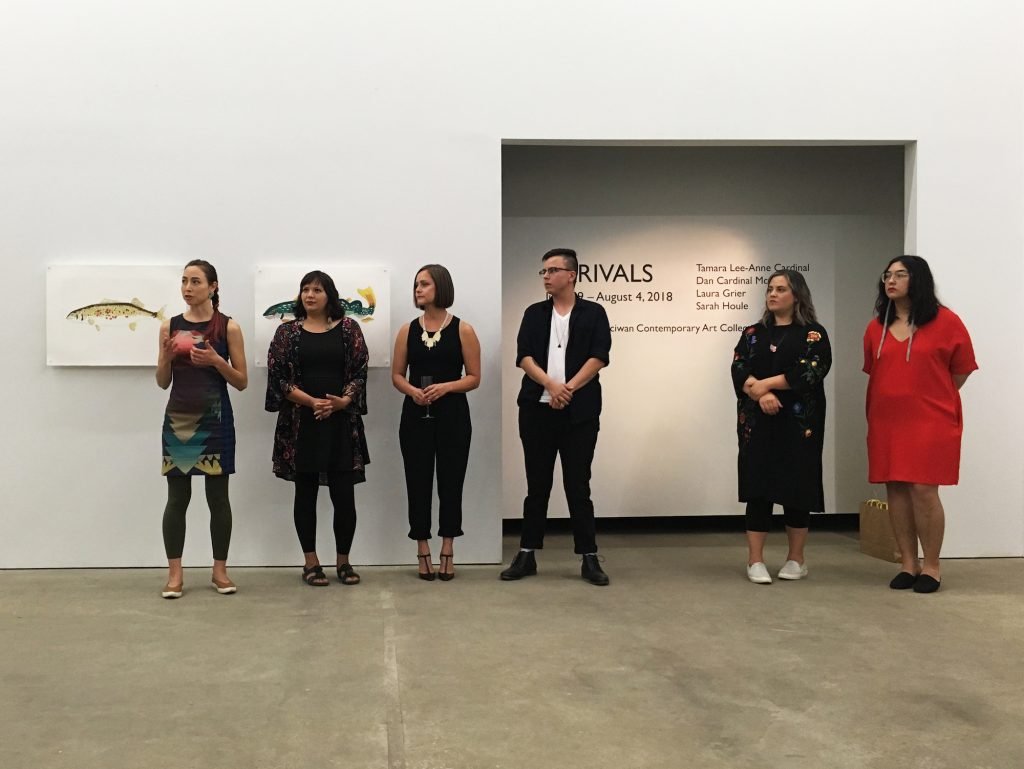
Ocicwan’s Erin Sutherland & Jade Nasogaluak Carpenter on Arrivals
July 5, 2018
“I think there are a lot of people out there who support artists and we’re just one of them. We’re not really advocates; we add our voice. We create spaces for artists to show and to create these conversations.”Curated by Jade Nasogaluak Carpenter & Erin Sutherland of Ociciwan Contemporary Art Collective, Arrivals is an exhibition featuring the work of four emerging Indigenous artists: Tamara Lee-Anne Cardinal, Dan Cardinal McCartney, Laura Grier, and Sarah Houle. On the occasion of Arrivals, Jessa Gillespie of dc3 Art Projects sat down with Erin Sutherland & Jade Nasogaluak Carpenter to discuss Ociciwan’s mandate and curatorial interests. This exhibition is open to the public at dc3 Art Projects from June 29 – August 4, 2018.
< jessa gillespie > To begin, could both introduce yourselves and your individual interests/practices?
< jade nasogaluak carpenter > I’m Jade Nasogaluak Carpenter, a visual artist and emerging curator based in Alberta. My art practice deals with issues of diaspora and uses humor as a coping mechanism to navigate trauma. Currently, I have soapstone carvings in Montreal at the Contemporary Indigenous Art Biennial/la Biennale d’Art Contemporain Autochtone (BACA) curated by Becca Taylor and Niki Little. I’m also on the curatorial team for the Inuit Art Centre, opening in 2020.
< erin sutherland > I’m Erin Sutherland, I am an independent curator and core member of Ociciwan Contemporary Art Collective. I am based in Edmonton and Camrose, and am an Assistant Professor of Cultural Studies at the University of Alberta’s Augustana campus. My research practice focuses on Indigenous contemporary art, Canadian art, Indigenous performance art, and Indigenous territorial methodologies. I’m also really interested in the history of Indigenous curating. My curatorial practice focuses predominantly on performance art but I’m also really interested in embodied practices – practices that think about the role of the body.
< jessa gillespie > Could you speak a bit about how Ociciwan came into fruition? What was the initial drive?
< erin sutherland > In 2015, Kristy Trinier, Tiffany Shaw-Collinge, Brenda Draney, and a number of people began talking about the need for more support of Indigenous contemporary art and more visibility of Indigenous contemporary art. There were great people working here and there were curators here (in Edmonton) that wanted to support this community and also bring in people that were doing really interesting work. I was brought in in December 2014, and we started having community meetings that asked what the Edmonton community needed, and we saw this lack of support for Indigenous contemporary art. There’s a really wide range of work going on here, and we wanted to add to it. We thought we could do something within that space and try to build on what’s already here and work with that pre-existing community. We started as a collective in 2015 and we’ve been curating without a space since then. We base our governance in Indigenous methodologies – relationship-building and centering collaboration. Ociciwan has been doing projects that we’re really interested in as individual curators, but just trying to raise the profile of what’s going on here in Edmonton and Alberta. So that’s how we started! I got roped in later, but really it was Tiffany, Kristy, and Brenda that got it going.
< jessa gillespie > When did you get involved? [to Jade]
< jade nasogaluak carpenter > Just last year.
< jessa gillespie > And you started in 2014? [to Erin]
< erin sutherland > We created Ociciwan all together. It was myself, Brenda, Tiffany, and Kristy, that started Ociciwan and then Becca came in. But the original conversations about the need for something like this was also with Brenda Draney and community members.
< jade nasogaluak carpenter > And Amy Malbeuf, did she join later?
< erin sutherland > Yes she joined after, and she was not able to stay with us because her art practice was just blowing up. And we are so excited for her! Amy joined after Becca, and Becca joined in the summer of 2015 – when the first Nuit Blanche occurred – that was our first show. Since then we’ve tried to do a couple shows a year – and it’s just increasing. We’ve been really honoured by the feedback.
< jessa gillespie > Since 2015, how has Ociciwan’s mandate shifted/evolved/been reinforced through time?
< jade nasogaluak carpenter > Well I wasn’t there in the beginning, but it seems like from what I understand of Ociciwan, it’s morphed into a curatorial collective.
< erin sutherland > We’ve always been a curatorial collective. It’s always been our aim to curate. It’s interesting that that’s your perspective.
< jade nasogaluak carpenter > I guess in the beginning I thought it was a collective that supported artists – but I suppose that means curation as well.
< erin sutherland > I mean, I think we support through curation, although we’ve also done some mentorship stuff – workshops that we open to the public. That’s a huge part, mentorship and support. But I would say 99% of our support is through curating and building relationships. We do that also through doing workshops and I think we’d like to do more of that but it’s just, you do what you can with what you have. But I would say our mandate is very open in order to allow for us to do what we understand needs to be done.
< jessa gillespie > Yeah it allows you to fluidly support, instead of just strictly curating, which is nice.
< erin sutherland > I think there are a lot of people out there who support artists and we’re just one of them. We’re not really advocates; we add our voice. We create spaces for artists to show and to create these conversations. There are a lot of supports out there for a number of different kinds of artists, we just add to that. We’re not doing anything people weren’t doing before – we’re just doing what we like to do.
< jessa gillespie > I’m wondering if you could talk a bit about the curation of Arrivals, and how it fits within Ociciwan’s mandate.
< jade nasogaluak carpenter > The other members of Ociciwan were encouraging me to be involved in a project, rather than being involved in the Collective peripherally, so I teamed up with Erin for Arrivals. At first, the theme very generally was “emerging Indigenous artists based in Alberta”. I lived in Calgary for five years and am more familiar with the Calgary arts scene than Edmonton’s, so most of the artists in Arrivals ended up being from Calgary. I think with Arrivals we wanted to make space for emerging Indigenous artists and elevate them to the standard of a beautiful space like dc3.
< erin sutherland > A huge part of our mandate is organizing things that show off Indigenous art in Edmonton and in Alberta, and making space for that. If you only make space for the people who are really successful, then the people that haven’t been able to be successful yet never get to come up – that’s the most important. It’s cool to see what’s being created and what everyone who is successful is doing, but what are we going to do when those people go away. We always need to be supporting one another, but also making sure that this conversation we’re starting through the curation of Indigenous contemporary art is able to be continued not only through our work. Again, we’re adding to a voice that’s there, making sure there’s a continuance.
< jessa gillespie > It’s exciting that the collective is taking on such wide spread projects. Giving four emerging artists this sort of platform to communicate is huge. Especially because, and I’m not totally sure what Calgary is like, but Edmonton can be a tough place as an emerging artist – a lot of spaces don’t feel accessible. So it’s super invigorating to see a collective taking on this sort of project.
I was wondering if you two could give a brief description of the four artists within Arrivals and how they fit into your idea of emerging artists – broadly.
< erin sutherland > Oh man, that term emerging is so hard to define. I think here we just decided that it was artists who hadn’t exhibited much work. There’s so many artists that are doing incredible work, but for this exhibition we tried to center it around notions of the family, the body, the land – things that are interesting to Jade and I. It ended up resulting in the pieces working together – I guess through this idea of relationships really. Relationships to family, relationships to body, relationships to land – that’s where it ended up – which are all themes that are so important to Ociciwan.
< jade nasogaluak carpenter > I think through the curation we wanted to make it as intersectional as possible by including different voices that don’t necessarily fall within the canon of Indigenous or feminist art. Because I don’t think those categories necessarily define what Indigenous people ever were.
Catch Jade Nasogaluak Carpenter’s drawings in Peripheral Review and in various exhibition spaces around Alberta over the next two years, as part of TREX, curated by Derrick Chang of The Art Gallery of Grande Prairie. Also, keep an eye out for Erin Sutherland’s article on Mi’kmaq artist Meagan Musseau, in the Fall Issue of Canadian Art.
